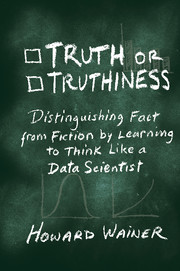Book contents
Section I - Thinking Like a Data Scientist
Published online by Cambridge University Press: 05 December 2015
Summary
Introduction
Not all of data science requires the mastery of deep ideas; sometimes aid in thinking can come from some simple rules of thumb. We start with a couple of warm-up chapters to get us thinking about evidence. In the first, I show how the Rule of 72, long used in finance, can have much wider application. Chapter 2 examines a puzzle posed by a New York Times music critic, why are there so many piano virtuosos? By adjoining this puzzle with a parallel one in athletics I unravel both with one simple twist of my statistical wrist. In these two chapters we also meet two important statistical concepts: (1) the value of an approximate answer and (2) that the likelihood of extreme observations increases apace with the size of the sample. This latter idea – that, for example, the tallest person in a group of one hundred is likely not as tall as the tallest in a group of one thousand – although this result can be expressed explicitly with a little mathematics it can be understood intuitively without them and so be used to explain phenomena we encounter every day.
I consider the most important contribution to scientific thinking since David Hume to be Donald B. Rubin's Model for Causal Inference. Rubin's Model is the heart of this section and of this book. Although the fundamental ideas of Rubin's Model are easy to state, the deep contemplation of counterfactual conditionals can give you a headache. Yet the mastery of it changes you. In a very real sense learning this approach to causal inference is closely akin to learning how to swim or how to read. They are difficult tasks both, but once mastered you are changed forever. After learning to read or to swim, it is hard to imagine what it was like not being able to do so. In the same way, once you absorb Rubin's Model your thinking about the world will change. It will make you powerfully skeptical, pointing the way to truly find things out. In Chapter 3 I illustrate how to use this approach to assess of the causal effect of school performance on happiness as well as the opposite: the causal effect happiness has on school performance.
- Type
- Chapter
- Information
- Truth or TruthinessDistinguishing Fact from Fiction by Learning to Think Like a Data Scientist, pp. 11 - 13Publisher: Cambridge University PressPrint publication year: 2015



